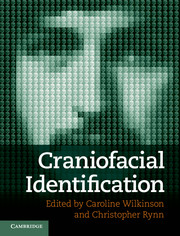Book contents
- Frontmatter
- Contents
- Contributors
- Part I Identification of the Living
- Part II Identification of the Dead
- Chapter 14 Post-mortem prediction of facial appearance
- Chapter 15 Manual forensic facial reconstruction
- Chapter 16 Relationships between the skull and face
- Chapter 17 Automated facial reconstruction
- Chapter 18 Computer-generated facial depiction
- Chapter 19 Craniofacial superimposition
- Chapter 20 Juvenile facial reconstruction
- Index
- Plate Section
- References
Chapter 20 - Juvenile facial reconstruction
Published online by Cambridge University Press: 05 May 2012
- Frontmatter
- Contents
- Contributors
- Part I Identification of the Living
- Part II Identification of the Dead
- Chapter 14 Post-mortem prediction of facial appearance
- Chapter 15 Manual forensic facial reconstruction
- Chapter 16 Relationships between the skull and face
- Chapter 17 Automated facial reconstruction
- Chapter 18 Computer-generated facial depiction
- Chapter 19 Craniofacial superimposition
- Chapter 20 Juvenile facial reconstruction
- Index
- Plate Section
- References
Summary
Introduction
The reconstruction of the face of a child is different from adult facial reconstruction. There are many difficulties associated with juvenile remains, including less accurate sex and ancestry assignment, the more emotive and sensitive nature of an investigation into the death of an unknown child, and the less-defined skeletal details associated with underdeveloped skulls. There also may be advantages associated with juvenile remains, such as increased public awareness, increased media attention and more accurate age estimation. Historically this subject has not been separated from adult facial reconstruction, although the differences between adult and juvenile skulls are significant.
Facial growth
The development of the skull throughout childhood produces extreme changes in facial appearance and these may be so drastic that an infant might become unrecognisable after only a few months (Y’Edynak and Işcan, 1993). There are three principal regions of craniofacial development: the brain and basicranium, the facial and pharyngeal airway, and the oral complex. Each of these regions has its own timetable of development, but all are inseparably linked as an interrelated whole (Enlow and Hans, 1996).
- Type
- Chapter
- Information
- Craniofacial Identification , pp. 254 - 260Publisher: Cambridge University PressPrint publication year: 2012
References
- 1
- Cited by



